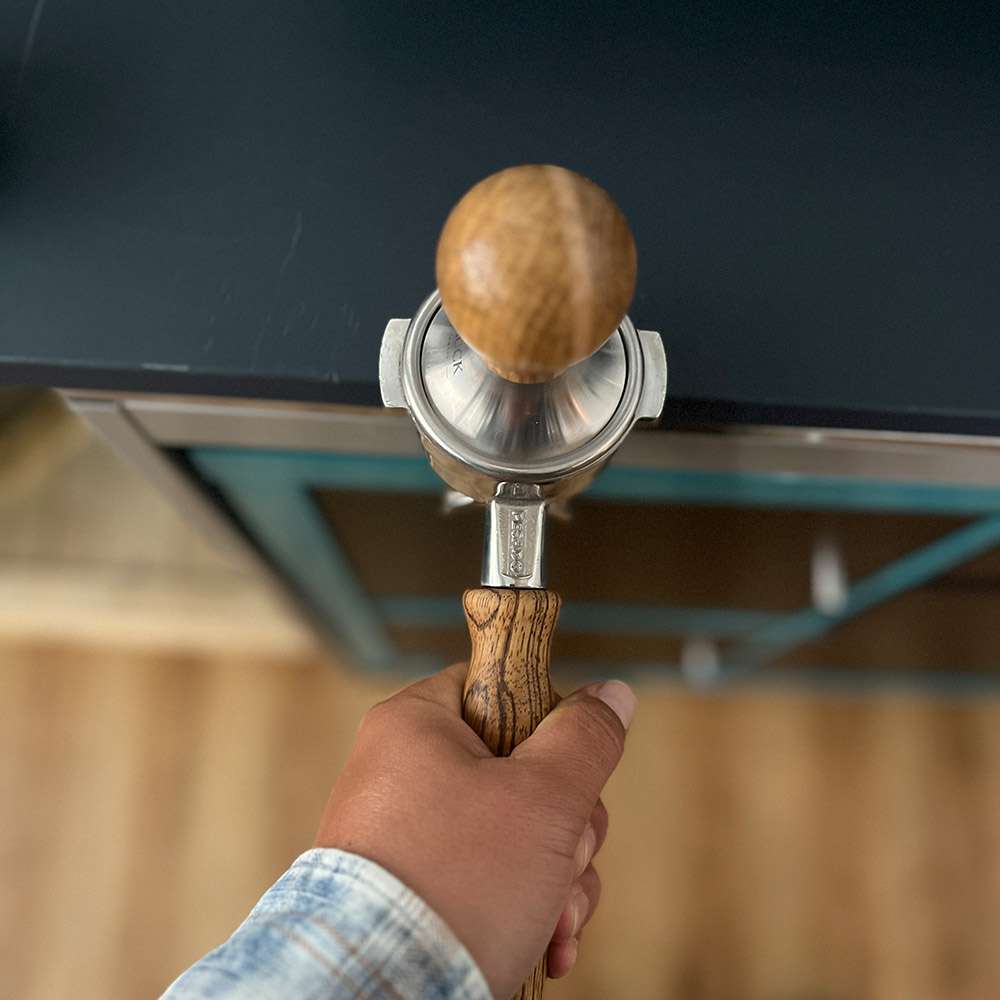A tamper, this unassuming tool, plays a crucial role in the world of coffee making, especially for espresso lovers. Its influence on the taste and quality of the final product is undeniable. In this detailed guide, we will take a thorough look at the tamper - from its definition to the different types and tips on choosing the right tamper for your needs.
What is a tamper?
A tamper is a tool used in coffee making to compact ground coffee in a portafilter. Its main function is to create a uniform and solid surface and density of the coffee powder to ensure consistent extraction during the brewing process. The consistency of the tamping plays a key role in preparing a perfect espresso by having a direct impact on the quality and taste of the drink.

What do you need it for?
Using a tamper is crucial as it directly affects the quality of the espresso. By compacting the coffee grounds, the resistance to the water is increased, resulting in a more even brewing process. A good tamper allows the water to flow evenly through the coffee, resulting in optimal extraction of aromas and oils, thus creating a rich, full flavor. Without a tamper, the water could flow unevenly through the coffee grounds, which can result in poorer flavor and unwanted bitterness.
Shapes of tampers
The tamper has a base, i.e. the surface that you press into the ground coffee. This comes in two main forms: flat and convex, i.e. flat and curved outwards. Both forms have their right to exist. We explain the differences.
Flat tamper
The flat tamper represents the most traditional form and has a flat, level base. It is ideal for beginners as it is easy to handle and ensures an even surface of the coffee powder. It also creates a puck that is the same thickness and hopefully the same density everywhere. For example, you can find the Hauck tamper here.
Convex tamper
In contrast to the flat tamper, the convex tamper has a curved bottom. A convex bottom is intended to make the coffee puck more stable. This is because the sensitive area in the sieve after tamping is logically exactly the border between the coffee puck and the sieve wall. Basically, the curved shape leads to a stronger compression of the coffee grounds on the sides of the sieve. This means that no gap can form between the coffee puck and the sieve wall. The disadvantage of this tamper is that the puck again has different thicknesses and thus a density imbalance.
Adjustable tamper
The popular opinion is that you should compress the coffee in the sieve with 15 kg of pressure. That's not really wrong. 10 kg is just as good as 17 kg, of course, the main thing is that you press the air out of the coffee puck. However, clever companies have taken advantage of these 15 kg and developed pre-set tampers. They have an integrated spring that only reacts when a certain pressure - 15 kg - is applied. Some even have an LED installed that shows you how much pressure you are pressing with.
Tamper without handle
Tampers without handles are also relatively new on the market. They look more like buzzers from a quiz show than stamps and are advertised as having a lower risk of injury. If you can even talk about a risk of injury when tamping. In any case, it sounds reasonable, as the pressing movement is actually a lot more natural than with a conventional tamper.
Lever tamper station
If you have a lot of tamping to do, you can also consider a lever tamper station. You place the brewing sieve with the coffee in the station. Then you press a lever down. The triggered mechanism presses and compresses the coffee in the sieve evenly. After tamping, the stamp automatically springs back. This makes the whole process child's play.

Tamper machines
This is also intended for frequent tampers: mechanical tamper machines, such as those from PUQpress . All you have to do is put the sieve with the coffee in the device and the machine does everything else at the touch of a button. This is particularly suitable in the catering sector if you serve a large number of espressos every day. You can often set the pressure in advance and then the machine always presses with the same pressure.
Levellers
The leveler is not a tamper, but should at least be mentioned here. Because before tamping comes leveling. By leveling correctly, you can be sure that the ground coffee is evenly distributed in the sieve. This means that nothing can go wrong when tamping later and the puck should always be evenly compacted after a bit of practice. In our shop you can find the Equalizer from Hauck or the NCD from Nucleus Coffee Tools.
Choosing the tamper: What you should pay attention to
Now it's time to get down to business. You want to buy a tamper. And there are tons of them out there. When choosing a tamper, there are several factors to consider to ensure that it's the best fit for your needs. Here are the points to consider.
diameter
The diameter of the tamper should exactly match the diameter of the portafilter. This ensures even compaction of the coffee powder and optimal extraction. If the tamper is too small, it will not be compacted well, especially on the sieve walls, and channeling can occur.
Weight
A heavy tamper can help the barista achieve an even compaction with less effort. A balanced weight is crucial to ensure effective use, but ultimately it has to feel good in your hand.
material
Tampers are available in various materials, including stainless steel, aluminum and wood. Often in combination. The choice of material influences the weight, durability and aesthetic appearance of the tamper. The main selection criterion here is once again your taste, because you have to work with it.
Handle
The handle should fit comfortably in your hand and allow good control over the tamping process. A non-slip handle is particularly important to avoid accidents. Or you can choose a handleless tamper, then the risk of slipping is already minimized.
Price
The price range for tampers is wide. It is important to find a balance between quality and price. A high-quality tamper can significantly improve the quality of espresso, but there are also affordable options that can deliver good results. It's up to you and your wallet to decide.

The art of tamping
Tamping is more than just pressing the coffee grounds. It is an art that requires experience, technique and precision. The right tamping technique can have a significant impact on the quality of your espresso. It is advisable to experiment with different tamping techniques to find out which one works best for you. Applying even pressure across the entire coffee grounds is crucial to ensure an even extraction. Some baristas prefer a rotating motion while tamping to ensure the grounds are evenly compacted.
It is important – when using a tamper with a handle – to hold the tamper like a screwdriver, so that the tamper is a direct extension of your arm. You should then tamp vertically without slipping to one side or the other of the sieve.
Conclusion
Overall, the tamper is a crucial tool for any serious barista who strives for the highest quality in espresso extraction. The correct selection and use of the tamper can make the difference between an average and an exceptional espresso. However, your handling of the device is more important than the product itself. Take the time to find the perfect tamper for your needs and experiment with different techniques to get the most out of your espresso experience.



